Alice Springs is located in Australia’s Northern Territory, in Central Australia, halfway between Darwin and Adelaide. Often called the capital of the Red Centre, the town of Alice Springs, which is set on
a plain surrounded by ancient mountain ranges and
a landscape of arid beauty, is the second-largest city in the Northern Territory after Darwin.
The Aboriginal Arrernte People
The Aboriginal Arrernte (pronounced arrunda) people have lived around the region encompassing Alice Springs for many thousands of years. The Aboriginal name for the region is
Mparntwe (pronounced m’barn-twa).
Two important Arrernte songlines of Alice Springs concern the Wild Dog and Caterpillar Dreaming stories. In these creation stories, the ancestral spirits which emerged from the ground could change from animal to human form. In this time of the Dreaming, the world was flat and there were no landmarks. According to traditional Arrernte beliefs, the dog fought a battle at Alice Springs, which shaped the landscape and then, it transformed into a boulder at
Akeyulerre (Billy Goat Hill).
Interestingly, the Arrernte people used sign language along with spoken language. This sign language, also known as
Iltyeme-iltyeme, appears to be related to speech taboos. For example, where a man and his mother-in-law are forbidden to directly speak to each other. Avoidance
relationships differ across tribal groups throughout the Australia.
Doris Blackwell arrived at Alice Springs with her parents in 1899, she wrote in her book
Alice on the Line (1965), that she had seen about 150 Aborigines camping beside the Todd River. The Northern Territory Administrator stated in 1914 that there were "....120 to 140
Aboriginals permanently camped at Alice Springs".
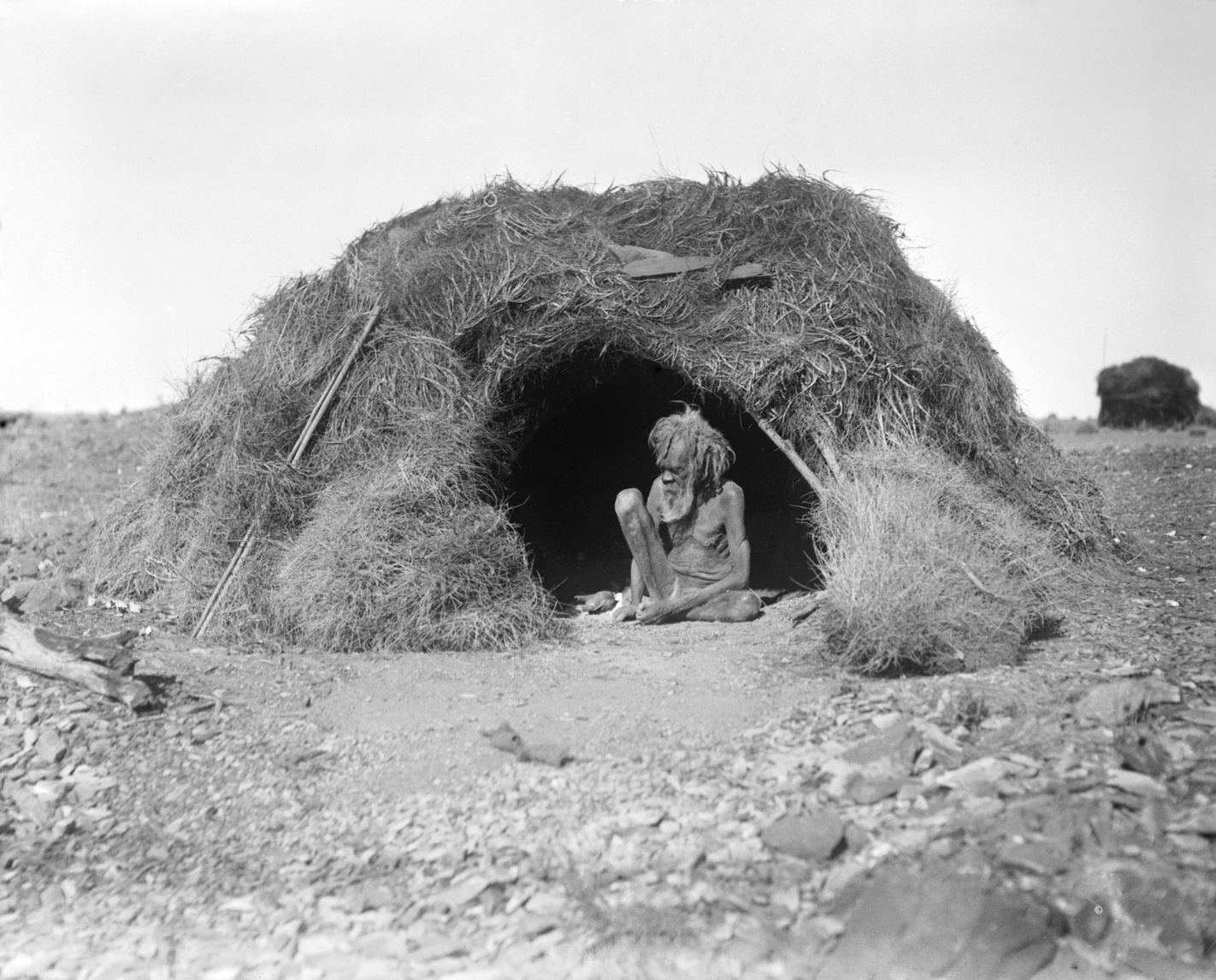 |
| Hut decked with porcupine grass, Eastern Arrernte people, Arltunga district, Northern Territory. Herbert Basedow, National Museum of Australia |
 |
| Walter Baldwin Spencer and Francis J Gillen - Baldwin Spencer seated with the Arrernte elders, Alice Springs, Central Australia, 1896. - Google Art Project |
 |
| Arrernte welcoming dance, entrance of the strangers, Alice Springs, Central Australia, 9 May 1901 |
 |
| "Members of a Family of Arunta Natives", Date of publication: 1899 |
 |
| "Rain dance, Arunta tribe", Date of publication: 1899 |
 |
| Ceremony of the kangaroo totem. Man lying down is supposed to be a dog. Date of publication: 1899 |
 |
| "The Native Tribes of Central Australia [With illustrations.] "Author(s): Spencer, Baldwin, Sir, 1860-1929, British Library |
European Exploration and Arrival
The Scottish explorer, John McDouall Stuart (1815 –1866), led the first successful expedition to traverse the Australian continent, travelling through the centre of Australia, from south to north and back again in 1861–62. The expedition passing to the west of what would later become Alice Springs, through the MacDonnell Ranges and Brinkley Bluff.
The route mapped by Stuart opened the way for European settlement into Central Australia with pastoral Leases being granted on 1 April 1872, to Edward Meade Bagot, who won a contract in 1870, to construct a portion of the Overland Telegraph line and Joseph Gilbert. However, the introduction of cattle farming to the arid Central Desert environment would have a detrimental effect on the Aboriginal way of life and increase the extinction rate of many native plants and animals.
The Overland Telegraph, "the greatest engineering feat of 19th century Australia", connected the towns of Australia and Australia, with England, by a single wire.
Alice Springs Telegraph Station, which is four kilometres north of the Alice Springs town, was first recorded by the surveyor William Mills in March 1871, when he was searching for a suitable route for the telegraph line through the MacDonnell Ranges. Mills wrote in his diary:
"numerous waterholes and springs, the principal of which is the Alice Spring which I had the honour of naming after Mrs Todd."
Mrs Todd was the wife of Mills' employer, Charles Todd.
 |
| Alice Springs Gaol. Timber lock up with a corrugated iron roof Alice Springs, circa 1881. Northern Territory Library. The Heavitree Gap Gaol was Central Australia's first prison. It opened in a small wooden police hut at Heavitree Gap near Alice Springs in 1904. The Gaol closed in 1909 and was replaced by Stuart Town Gaol |
The Cameleers
It was the so-called Afghan Cameleers who carried the poles, wires, food, water and other supplies needed for the construction of the Overland Telegraph Line and stations and to the men building the desert railways to Oodnadatta and Alice Springs. Some of these cameleers were named Mahomet, Peer Mahomet and Charlie Sadadeen. The cameleers were actually from a variety of south-central Asian, Middle Eastern and Indian subcontinental ethnic groups.
At a heritage site officially declared in Alice Springs, the grave of Goolam Rasool Nazar, is a reminder of the Afghan cameleers and this period in Australia's development. Today many feral camels also roam Central Australia around Alice Springs.
 |
| Grave of Goolam Rasool Nazar, situated just off Tuncks Road, Alice Springs |
 |
| The Mohammedan Mosque. State Library of SA. A mosque used to stand on the site where the Alice Springs Public Library now exists, built by Charlie Sadadeen. The windmill which can be seen may have caused a sinkhole outside the library in 2016 |
 |
| Camel train laden with chaff for interior stations in the far North with an Afghan camel driver. Six camels make up the camel train. State Library of SA |
The Overland Telegraph
The South Australian Government, along with Charles Todd, built the 3200-kilometre overland telegraph line which connected Darwin with Port Augusta, while the British-Australian Telegraph Company lay the submarine cable from Java to Darwin. In 1872 the Overland Telegraph was completed and Australia could communicate to the rest of the world in hours, rather than months or weeks.
 |
| Alice Springs Overland Telegraph Station, Chronicle (Adelaide, SA : 1895 - 1954), Saturday 2 September 1899 |
 |
| Alice Springs (Mparntwe) Telegraph Station marks the original site of the first European settlement in South Australia. It was established in 1871. Approximately 1896 |
 |
| Township of Stuart, identified by NT Library, circa 1896 |
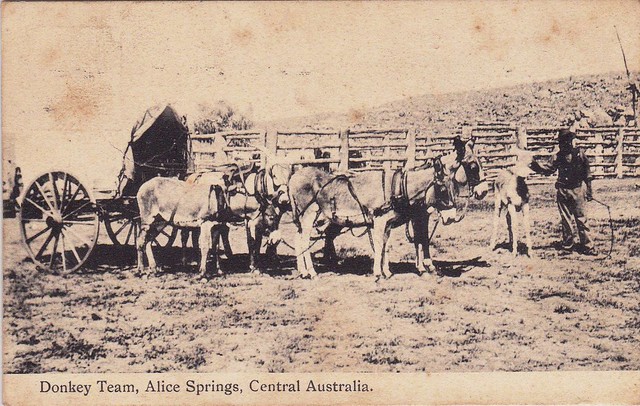 |
| Donkey team, Alice Springs, Central Australia - very early 1900s |
From Stuart To Alice
The present site of Alice Springs was surveyed in 1889 and named Stuart in the following year, after the explorer John McDouall Stuart. However, in 1933, the name was changed to Alice Springs.
The Horn Scientific Expedition which was sponsored by three Australian universities (University of Sydney, University of
Adelaide and University of Melbourne), occurred from May to August1894.
The
expedition first travelled by train from Adelaide to Oodnadatta in South Australia, then used camels
to travel the more than 3000 km of largely, uncharted country from Oodnadatta through the Finke River basin to Alice Springs and the Macdonnell Ranges in the Northern Territory.
 |
| Members of the Horn Expedition at Alice Springs. Pictured in the photograph are Francis W Belt, C Laycock, Edward Stirling, Ralph Tate, J Alexander Watt, Walter Baldwin Spencer, Charles Winnecke (principal author of the Journal of the Horn Scientific Exploring Expedition 1894 (published 1897), G A Keartland, Harry (tracker of the Native Mounted Police), Afghan camel drivers (Moosha and Guzzie Balooch), a prospector, and another camel man. Google Art Project |
In 1899, the European population of the Telegraph Station and Alice Springs (then called Stuart) stood at 30 (Blackwell and Lockwood 1965). However, Alice Spring's population experienced a boom as a service centre for miners and pastoralists after the discovery of alluvial gold, 110km’s east of Alice Springs in 1887 at Arltunga. Further population growth occurred when the railway line from Oodnadatta was extended to Alice Springs in 1929 and Alice Springs became the northern terminus of the Central Australia Railway. By 1932 there were around 200 Europeans in Alice Springs.
Electric lights came to Alice Springs in 1937.
 |
| Stuart Arms Hotel, Northern Territory, approximately 1900, corner Todd and Parsons Streets, Alice Springs. Demolished in 1986 |
.jpg) |
| Staff at the Alice Springs Telegraph Station, NT. From left to right: Mr P. Squire, Pat Moore, Mr B.W. Harris and Thomas Bradshaw. Thomas Andrew Bradshaw (1859–1934) was the postmaster of the Alice Springs Telegraph Station from 1899 until 1908. Bradshaw Primary School in Alice Springs is named after Thomas Bradshaw |
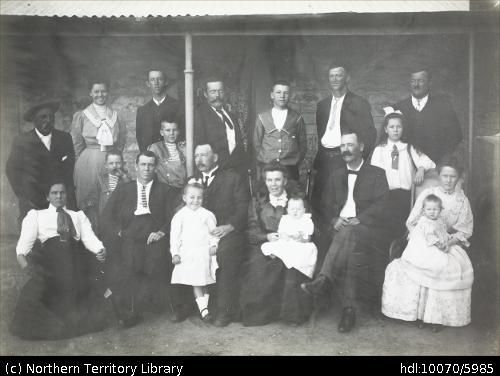 |
| Residents and staff of Alice Springs Telegraph Station, identified by NT Library, taken 10-May-1908 |
 |
| Charlie Meyer's shop, circa 1830, State Library of South Australia. Charlie Meyers (aka Aaron Schunke), was the local saddler. He married Annie Williams who arrived in Alice Springs in the late 1890s. Annie helped to deliver babies at Alice Springs and was the Foundation President of the Croquet Club. |
 |
| Postmen and their horses photographed at Alice Springs before travelling with the mail delivery for Powell's Creek, Northern Territory. About 1918. State Library of SA |
 |
| The Arunta tribe's camp near the government well at Alice Springs about half a mile from the town, circa 1924, SLSA |
A split occurred
From 1926 to 1931 the Northern Territory was divided into the territories of Central Australia and North Australia. Stuart (Alice Springs) was designated as the administrative capital of Central Australia in 1927. The Residency is a reminder of Alice Springs' brief period of legislative independence from the rest of the Northern Territory.
John Cawood was the first person to hold office as Government Resident of Central Australia, serving from 1926 till 1929. And his successor, Victor George Carrington, who served from 1929 to 1931, was the last person to hold the office.
.JPG) |
| The Residency was designed for an arid climate, with concrete floors laid directly onto the earth. The hollow concrete bricks, which resembled stone, were made on site in wooden sculpted moulds. Only one type of brick was actually used, but was concealed by a varied laying pattern. The building was completed in 1927 |
 |
| "Two aborigines from the Arunta tribe, of North Australia, Jack Noorywauka and Stan Loyrurrie, were busy on Saturday at the National Museum building a mia-mia for the forthcoming exhibition of Australian aboriginal art. Jack called upon Stan to admire the craftsmanship of an ancient carved stone axe." Argus (Melbourne, Vic. : 1848 - 1957), Monday 8 July 1929 |
Dark History
Contact with Europeans occurred much later for the Aboriginal people of Central Australian than in the south, mostly as the region was Australia's last colonial frontier. Aboriginal people reacted in a variety of ways to European settlers: fear, avoidance, curiosity and attacks. The Coniston massacre, which occurred 390 km north-west of Alice Springs, was the last known officially sanctioned massacre of Indigenous Australians, instigated, it is said, from fear that Europeans would be wiped out by the Aboriginals.
Gwoya Tjungurrayi, known by his nickname, One Pound Jimmy, who survived the Coniston Massacre in the then Territory of Central Australia in 1928, was the first Aboriginal person to feature on an Australian postage stamp.
 |
| A postage stamp of Australia, featuring Gwoya Tjungurrayi, issued 1950 |
 |
| New Call (Perth, WA : 1931 - 1934), Thursday 11 May 1933 |
 |
| Butcher's Shop, Alice Springs, NT, circa 1935, State Library of South Australia |
The Theatre
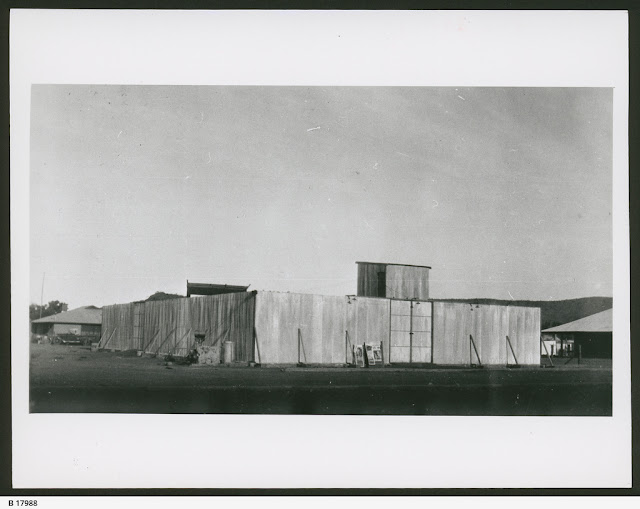 |
| Capitol Open Air Theatre, Alice Springs, NT, circa 1936. Outdoor Moving Picture Theatre at Alice Springs. “In construction”, SA State Library |
The Capitol Theatre was built by the Underdown family and located opposite the Hotel Alice Springs (now a car park). Walter Schnitzer was a projectionist at the Capitol Theatre which closed in the 1960s.
 |
| The new "Pioneer" picture theatre, Alice Springs, NT. Northern Territory Library |
The Pioneer Walk-In Picture Theatre was built by Les “Snow” Kenna in 1942. Before this, Kenna showed movies at the Welfare Hall, a building which stood on stilts, in an area now known as Snow Kenna Park. In the 1960s, Kenna built the Pioneer Drive-In Theatre near the Stuart Highway. The above building still exists today, as the YHA Hostel (see below), as it was saved by members of the community who fought against its demolition.
 |
| Alice Springs Hotel, Northern Territory, circa 1936, State Library of SA |
 |
| The hospital at Alice Springs, Northern Territory - circa 1940 |
 |
| Central Queensland Herald (Rockhampton, Qld. : 1930 - 1956), Thursday 3 September 1942 |
 |
| Wallis Fogarty Limited's store in Alice Springs, Northern Territory, circa 1946. National Library of Australia |
 |
| Henry Peckham, Aboriginal rover from Alice Springs, made a brilliant debut on the Adelaide Oval on Saturday playing for West Adelaide against South Adelaide. He kicked five goals andwas full of vigor at the end of the day. Dozens rushed on to the oval to congratulate him and he received 23 telegrams, from Alice Springs and Darwin. Peckham appears in the group picture of West Adelaide taken on Saturday and included in the eight League teams for 1950 published onpages 24 and 25 of this issue. Chronicle (Adelaide, SA : 1895 - 1954), Thursday 18 May 1950 |
Military Base
The population of Alice Springs continued slowly until World War II when a military base was established in the region.
 |
| Alice Springs, NT, photo taken 1942-12-08. Camp of the 149TH Australasian General Transport Company. Australian War Memorial |
In 1947, Alice Springs' population stood at 1871. During the 1960s, the creation of the Pine Gap Space Research Facility, located 19km southwest of Alice Springs, increased the population and boosted the economy of Alice Springs again, as houses were built and there was an increased need for goods and services in the area. The greatest population increase occurred in relation to tourism, however, as thousands of travellers arrive each year from within Australia and overseas, to visit Alice Springs, and other attractions, such as Ayers Rock, the Olgas and Standley Chasm, in the region.
The Ghan transcontinental railway line was only completed in February 2004. The entire journey, between the cities of Adelaide, Alice Springs and Darwin, covers 2979km in 54 hours.
Connellan Airways
The Alice Springs Town Aerodrome opened in the late 1930s and in 1939, Connellan Airways was established by Edward John Connellan. Now the Central Australian Aviation Museum.
 |
| Albert Namatjira outside Government House, Sydney, circa 1947 |
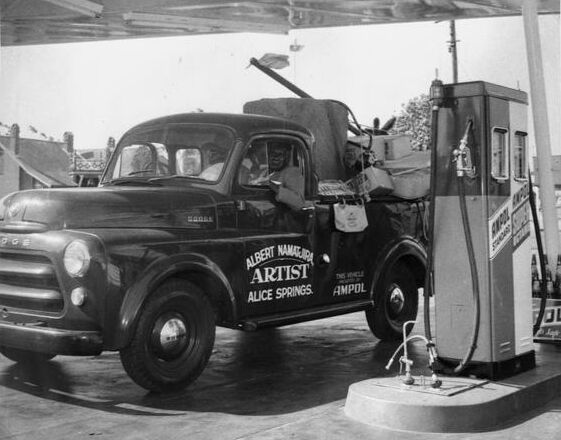 |
| Albert Namatjira refuelling for a trip to Alice Springs. Ampol branding is visible on the car itself as well as the bowser. Dodge B Series pickup truck, made 1948-53, circa [1947-1950?] National Library of Australia |
Albert Namatjira (1902 – 1959) was one of Australia's greatest artists. He was born and raised at the Hermannsburg Lutheran Mission outside Alice Springs and he was a member of the Arrernte people. Namatjira was interested in art from an early age, but he married at the age of 18 to Rubina, who was deemed to be of the wrong skin group, which meant that and he had violated tribal laws and so he was ostracised.
In the world of art criticism, Namatjira also had a difficult time, as some deemed his luminous and distinctive paintings to be derivative and conventional and others criticised the loss of tribal traditions in his work.
 |
| Mt. Hermannsburg, James Range, Northern Territory by Albert Namatjira |
Working as a camel drier for many years, it wasn't until Namatjira reached the age of 32, tutored by Rex Battarbee, that he began painting seriously. In 1956 Namatjira became the first Aboriginal person to win the Archibald Prize; he had also been awarded the Queen's Coronation Medal in 1953 and was honoured with an Australian postage stamp in 1968.
Doreen Braitling (nee Crook) (1904 –1979)
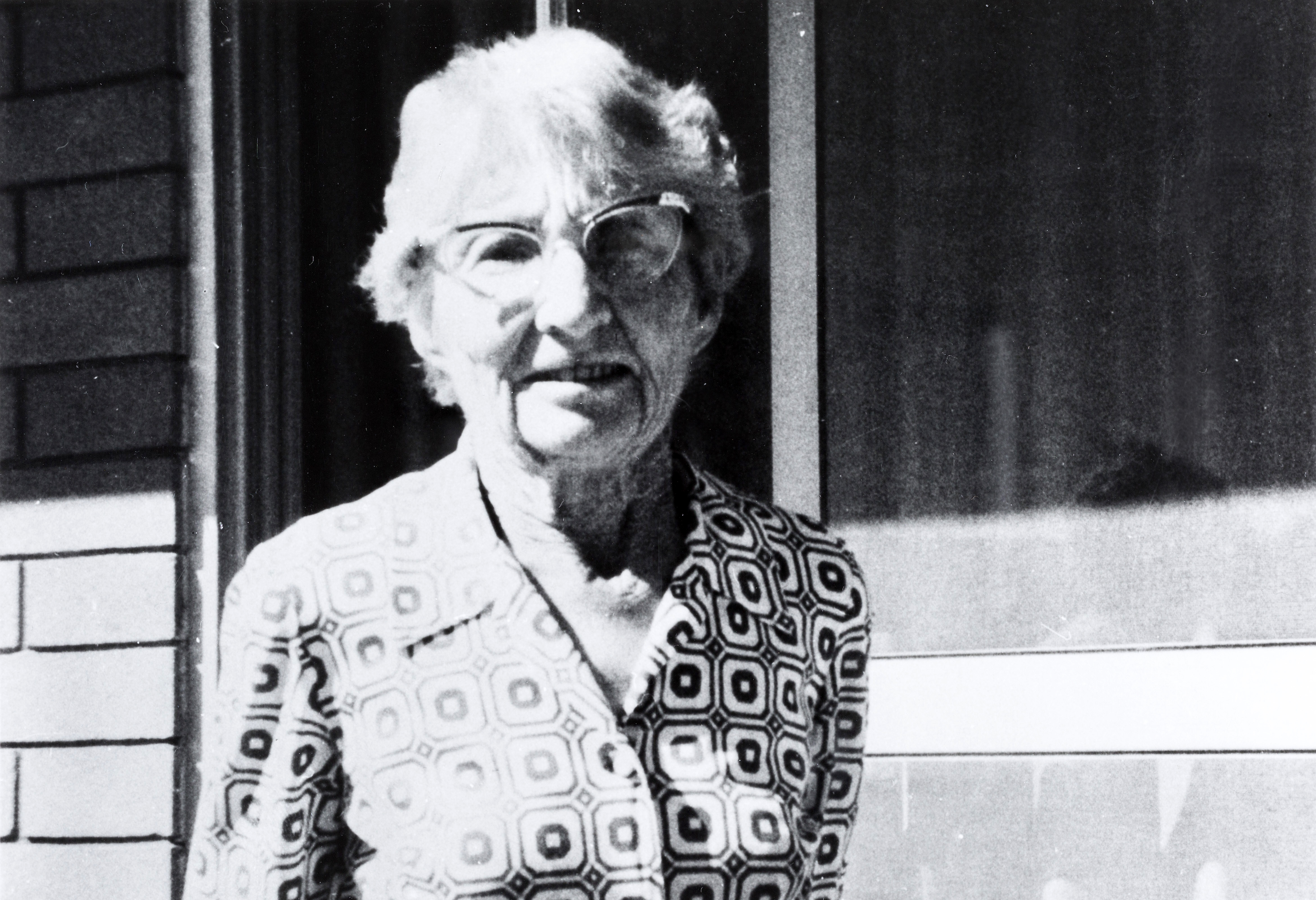 |
| Doreen Braitling, possibly at Mount Doreen Station, Ly Underdown Collection - Northern Territory Library. |
The suburb of Braitling in Alice Springs is named after Bill and Doreen Braitling, who established Mount Doreen Station in 1930. Braitling campaigned heavily against the destruction of old historical buildings and established a branch in Alice Springs of the National Trust and was elected as the first president.
Charles Perkins
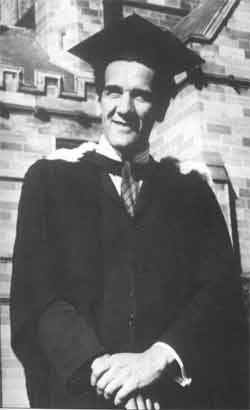 |
| Photo of Charles Perkins taken in approx. 1965 as a graduate from the University of Sydney |
Charles Perkins (1936 –2000) was born at Alice Springs and educated at St Mary's Church School. Later he attended St Francis House for Aboriginal Boys in Adelaide, the Metropolitan Business College Sydney and the University of Sydney, from where he graduated in 1966 with a Bachelor of Arts. He was the first person of Aboriginal descent to graduate from university in Australia. In 1965, Perkins was an important member of the Freedom Ride – a bus tour through New South Wales by activists protesting discrimination against Aboriginal people in small towns in NSW, Australia.
Mick Heenan
Mick Heenan was the first commercial market gardener and poultry farmer at Alice Springs. The Heenan Building on the corner of Todd Street, Alice Springs, was Heenan’s café and fruit and vegetable store. Over the years, the building has been used for a variety of purposes, including an art gallery.
 |
| Mick Heenan came to Alice Springs to die in 1929. In 1950, when this photo was taken, he was still going strong and became one of the town's most successful businessmen. State Library of WA |
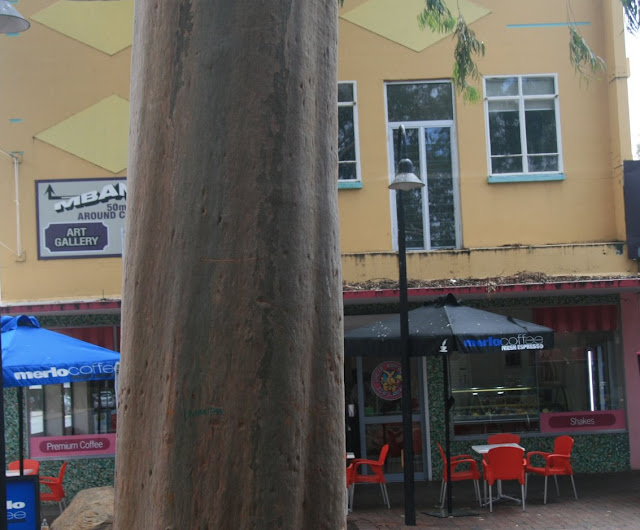 |
| The Heenan Building, Alice Springs, NT, built circa 1949 |
Around Alice Springs
 |
| Todd River spring, Alice Springs, NT, the "springs" that give the town its name |
 |
| Alice Springs Telegraph Station Historical Reserve, NT. The site of the Alice Springs Telegraph Station was first recorded by surveyor William Mills in March 1871, who was in search of a suitable route for the line through the MacDonnell Ranges. Built in 1872 as a repeater station for the Overland Telegraph Line, the Alice Springs Telegraph Station marks the first European settlement in Central Australia |
.JPG) |
| Exterior view of the Alice Springs Telegraph Station, now a museum adjacent to the Todd River, about 4 km north of Alice Springs, NT, Australia. Bahnfrend |
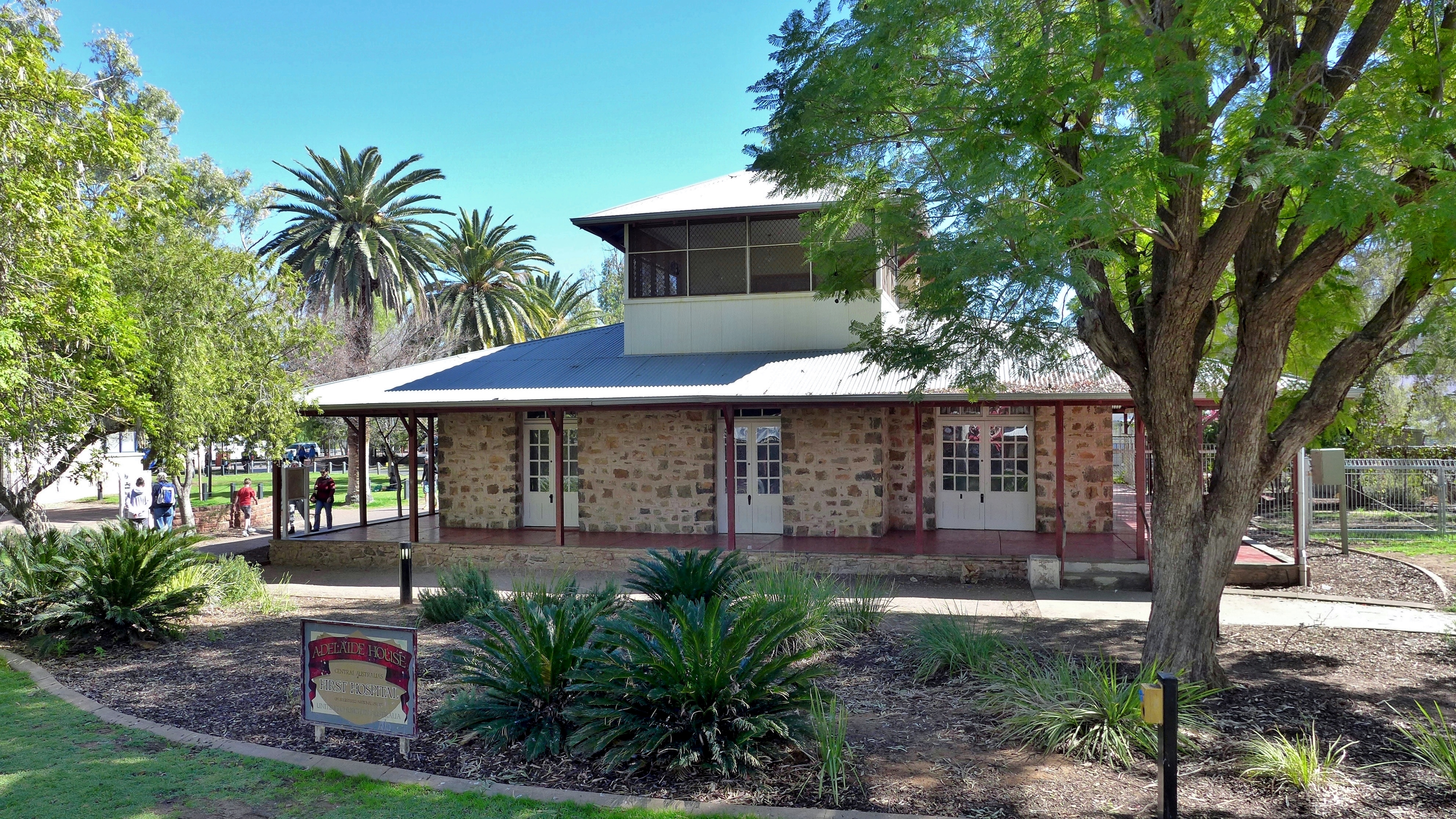 |
| View of Adelaide House, Alice Springs, NT, an historic building that was the first hospital in central Australia. Adelaide House, which was the region’s only hospital until 1939, was completed in 1927 to a design by the Rev. John Flynn, using a cooling system based upon the “Coolgardie safe” |
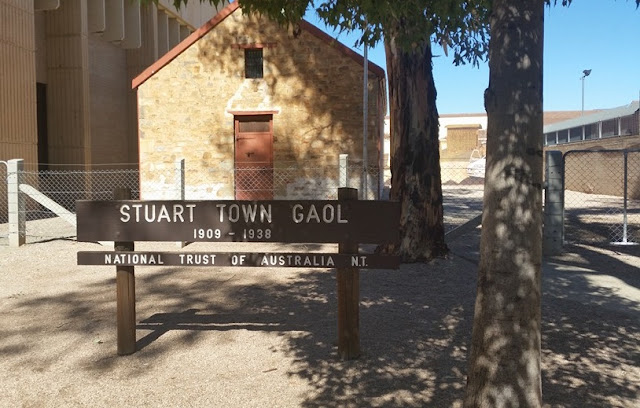 |
| Stuart town Gaol, 1905 -1938, Alice Springs, NT |
 |
| The Royal Flying Doctor Service Alice Springs, NT, circa 1939 heritage building |
.JPG) |
| The "Old Courthouse", Alice Springs, NT, constructed 1927-8 |
.JPG) |
| The Residency, 12 Parsons Street, Alice Springs, NT, was completed in 1927 |
.JPG) |
| Exterior view of the museum building at the Old Ghan Heritage Railway and Museum, 1930s-style railway station 10 km south of Alice Springs, NT, Australia. Bahnfrend |
 |
| Hartley Street School was the first official school building in Alice Springs, constructed in 1929. |
 |
| The original Alice Springs station, NT, opened in Railway Terrace in 1929, when the Central Australia Railway opened |
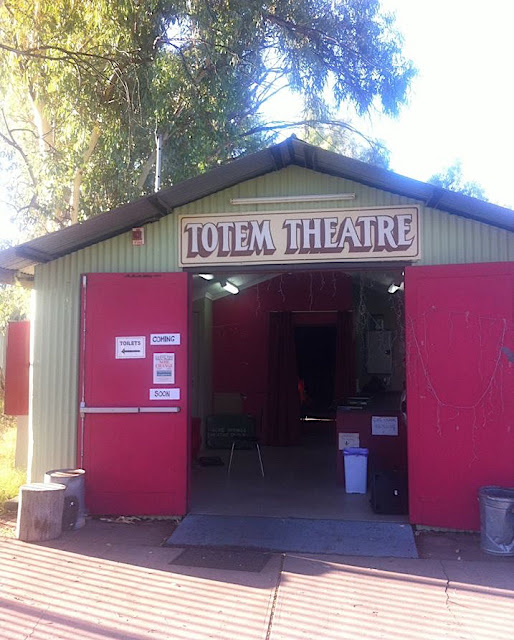 |
| The Totem Theatre is a heritage listed venue. The two main buildings, known as Sidney Williams Huts, were originally constructed in 1945 by the Australian Army |
 |
| John Flynn (1880-1951), Presbyterian minister, founder and superintendent of the Australian Inland Mission of the Presbyterian Church of Australia. He foundered the Australian Inland Mission Aerial Medical Service on the 15th May 1928 (later to be renamed the Royal Flying Doctor Service) |
.JPG) |
| View of Todd Street, Alice Springs, NT, Australia |
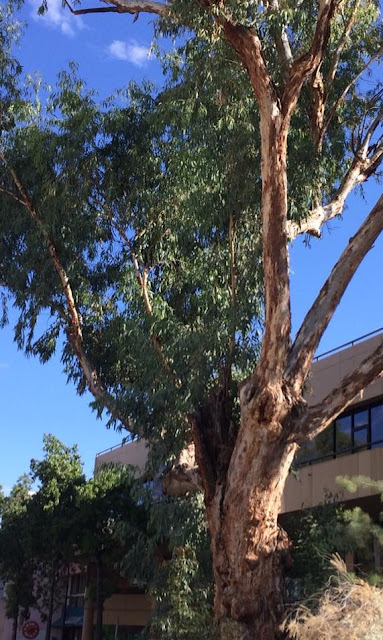 |
| The last river red gum to survive in the centre of Alice Springs is regarded as scared to the Arrernte people |
 |
| The former Art Deco Pioneer Walk-In Picture Theatre is located on the corner of Parsons Street and Leichhardt Terrace in Alice Springs. It was built in circa 1942 by Mr Leslie Joseph (‘Snow’) Kenna |
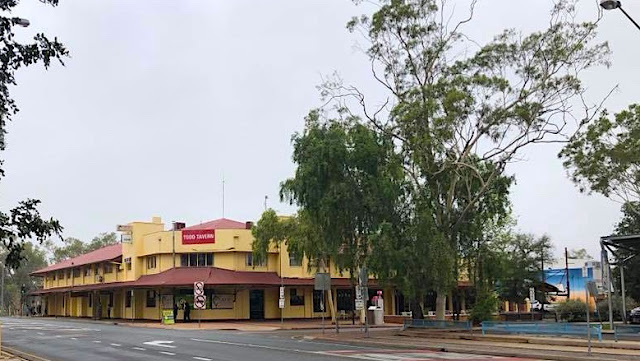 |
| The Riverside Hotel was built in 1960 and designed by architect, Beni Burnett. The hotel, which is the last traditional-style pub in Alice Springs has been re-named The Todd Tavern |
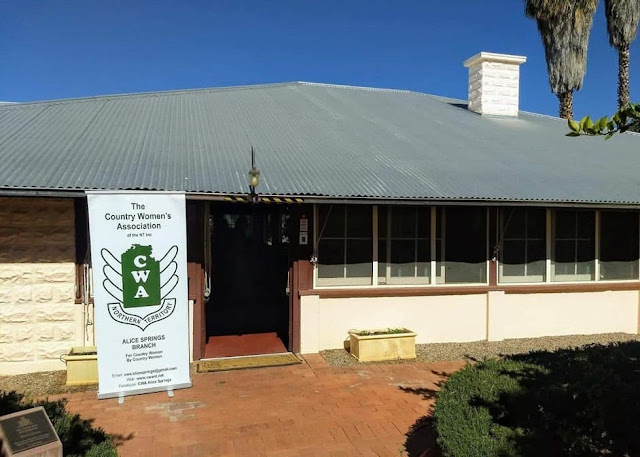 |
| The Country Women's Association of Alice Springs, NT, formed in 1933 |
 |
| The Alice Springs Desert Park is an environmental education facility and wildlife park in Alice Springs in the Northern Territory of Australia. The site is 1,300 hectares |
 |
| Olive Pink Botanic Garden is a 16-hectare botanic garden in Alice Springs in the Northern Territory of Australia, specialising in plants native to the arid central Australian region |
 |
| Pitchi Richi Sanctuary, is located about 4km south of the Town Centre. There are more than twenty William Ricketts sculptures, set in native garden |
 |
| Alice Springs, Nt, from Anzac Lookout |
 |
| Anzac memorial at Anzac Hill lookout - Alice Springs, NT |
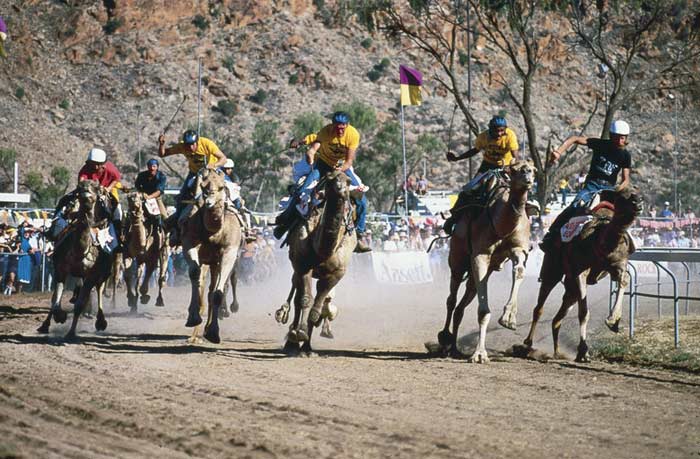 |
| Camel Cup, Alice Springs, NT, Tourism NT |
Araluen Cultural Precinct
Central Australian Aviation Museum
The National Road Transport Hall of Fame
The Old Ghan Heritage Railway and Museum
The Strehlow Research Centre
The Residency, Alice Springs
Hartley Street School Museum
Alice Springs CBD Map
Books To read
Alice Springs, by Stuart Traynor - Won the 2017 Chief Minister's Northern Territory History Book Award.
A Town Like Alice, by Nevil Shute - The story begins in England with a gentlemanly London soliciter setting up a trust. Then the story follows Jean Paget, who spent most of World War II in Malaya as a prisoner of the Japanese. She becomes romantically interested in a fellow prisoner and they move to Australia.
Alice Springs, (The New South Cities Series #7) by Eleanor Hogan. A description by the author about the area near her office in Alice Springs has been viewed by some readers as insightful and others, as too negative. You decide.
"
It’s more down-to-earth than where I was before, in the public service offices near the Mall in the central business district — perhaps almost a little too down-to-earth at times. Now and again there are splashes of broken glass across the path, including for a while the label of a vodka bottle crushed into the pavement. Sometimes there are trails of blood, tracing out stories of fights and assaults. And once a man lying in the middle of the road, a cordial bottle beside him filled with what looked like port."






















































.jpg)





